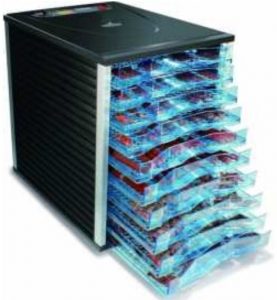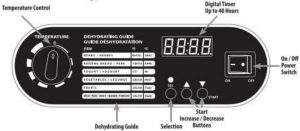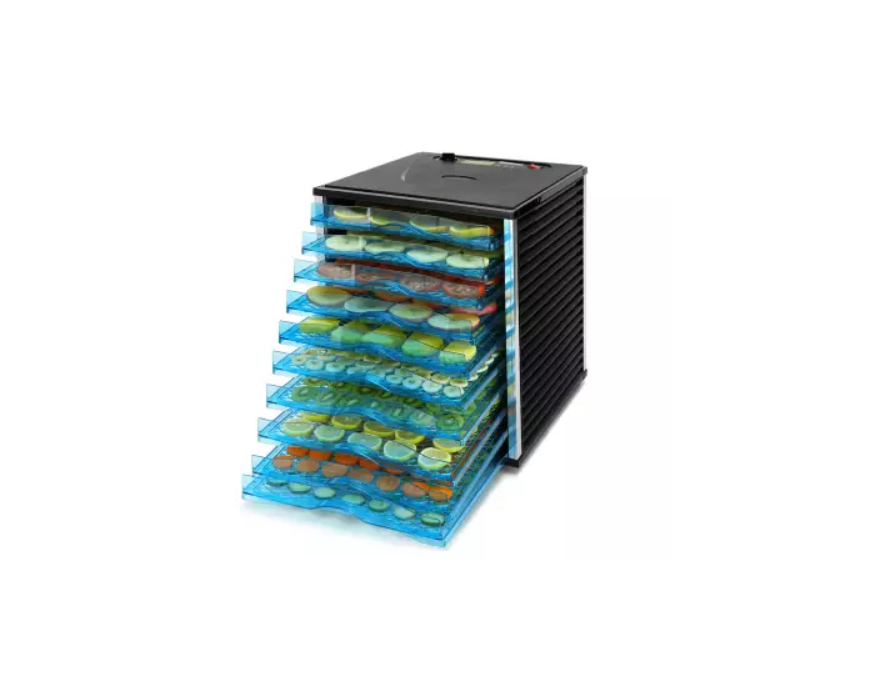kogan 10 Tray Food Dehydrator with Timer User Manual
Attention
Please handle this product with care and inspect it regularly to ensure it is in good working order.If the product, power supply cord or plug shows any signs of damage: stop use, unplug and contact Kogan.com support.
Safety & Warnings
- Do not touch hot surfaces or allow them to come into contact with flammable materials. Use handles or knobs.
- Do not immerse the cord, the plug or the base of the dehydrator in water or other liquid. Do not wash the appliance in sink or dishwasher.
- This appliance should not be used by or near children. Keep out of reach of children.
- Unplug from outlet when not in use and before cleaning. Allow to cool before putting on or taking off parts.
- Do not operate this appliance if it has a damaged cord or plug, if it is not working properly or if it has been damaged or dropped. If the supply cord is damaged, cease use immediately and contact Kogan.com.
- The use of accessory attachments other than those supplied or recommended by the manufacturer may cause hazards and can void your warranty.
- Arrange cord so that it cannot be caught or tripped over. Do not allow cord to hang over edge of table or counter. Keep cord away from hot surfaces.
- This appliance is for indoor, household use only. Do not use appliance outdoors or other than as described in this manual.
- To disconnect, turn the control to “OFF” before removing the plug from the outlet.
- Operate the dehydrator only in a clean, dust-free area. Dust and dirt can be drawn into the dehydrator and can contaminate the food being dried.
- Make sure the appliance and all controls are in OFF position before inserting plug in electrical outlet.
- Do not place the dehydrator on a towel or carpet. This will reduce or cut off the dehydrator’s airflow and could result in damage to the appliance.
- Always leave at least 32cm of space around the dehydrator on all sides for proper ventilation.
- To clean the heating base, unplug from wall outlet and wipe with damp cloth or sponge and mild soap. Do not immerse base or cord in water. Top lid and trays may be submerged in warm water and washed with mild soap or washed in TOP rack of dishwasher only. Heat from the drying cycle can warp trays which is not covered by warranty.
- Before each time you operate your food dehydrator, be sure to wash and dry the trays and any other parts which will contact the food.
- Only use the appliance on a suitable heat-resistant surface to avoid damage.
Setup


Before first use
Read the manual in full and retain for future reference.
Preparing for use
- Place the dehydrator on a flat, dry, stable and heat-protected surface. Ensure there is at least 3cm of clearance in all directions to allow proper ventilation.
- For best results, run the dehydrator for 45 minutes at 32°C for remove moisture from appliance before cooking.
- Prepare food according to the instructions given in this manual and fill the drying trays. NEVER cover the centre hole in the trays or the vents on the top lid.
- Before you begin preparing your food, wash and dry the trays, the lid and the tray liners, if they are to be used. Place dehydrator base where you intend to use it for the dehydration process and insure electrical cord reaches an outlet in a safe manner. This way, as you prepare the food, you can place it right on the trays. As a tray is filled, it can be placed on the dehydrator for easy setup.
- Before loading the trays with food, it is a good idea to make sure that they are all aligned fight-side up by stacking them up in one place near the preparation area. The narrow side of the tray always is the top. Trays have alignment arrows cast into the handle. The arrow (as seen below) should all be visible on the top of the tray handles. Improperly stacked trays will negatively affect the drying process.
- Once the trays are all right-side up you can stack them in two different ways. Depending on their orientation to each other, they can be set for thick or thin foods. To change the stacking height simply rotate a tray 180 degrees to change whether it is tall or short stacked. Refer to the two photos below to identify the difference between these two heights.
- Any combination of stacking can be used to accommodate the foods being dried. An example would be some short tray stacking for banana chips and some tall stacking for large strawberry halves. When properly stacked, trays will be locked into each other whether tall stacked or short stacked and in any combination there of.
Operation
How to use
- Set up as per the previous “Setup” section and plug into an electrical outlet.
- To set the Temperature, turn the knob to the appropriate temperature.
- To adjust the Time, press the Select button: the digital display will flash.
- Set the Hours with the arrow buttons, up to 40 hours.
- Press Select again and set the minutes with the arrow buttons.
- The display will show Time setting: press Select again to confirm.
- Press Start to begin dehydration process.
- Using oven mitts, slide the dehydrator trays out of the unit and load the product to be dehydrated onto the trays. For best results, do not overlap the product and be sure to leave space between the items to allow for maximum air circulation.
- Using both hands for maximum stability, slide the dehydrator trays back into the unit.
- Set the temperature by turning the knob on the top of the unit.
- Note: Moisture may collect on surface of the food. This should be blotted off with a paper towel.
Consult the various tables at the end of this manual to get an idea as to when food is properly dehydrated and ready to be stored.
Storing Food
Once food is properly dried, it is important to store it properly for best results. By following these storage techniques, your food will stay fresh and ready to use for the longest time possible.
Containers
Any container which is clean, airtight and moisture-proof is suitable for storage. Heavy, zippered plastic bags or heat-sealing cooking bags are excellent. Fill each bag as much as possible and squeeze out excess air. Filled bags may be placed in metal cans with lids (shortening or coffee cans are good) to keep out insects. Glass jars with tight-fitting lids can be used with or without plastic bags. Quality plastic containers with tight-fitting lids are good but they must be airtight. Do not use paper or cloth bags, lightweight plastic bags, bread wrappers, or any container without a tight-fitting lid.
Troubleshooting
|
Symptom |
Possible Cause |
Steps to Resolve |
| No HeatNo ran | No power | 1. Be sure unit IS plugged In. 2. Make sure power switch is on. 3. Check that outlet Is working. |
| No HeatFan-OK | Broken wire in unit | Contact Kogan Support |
| Heat-OK No Fan | Motor stalled or fan blocked |
|
| Slow drying |
|
|
| Uneven drying |
|
|
| Overheating or insufficient heat | Temperature control not functioning at proper range | Temperature in the lowest tray should be approximately 60°C with empty trays in place. If temperature varies significantly, adjust accordingly higher or lower or contact Kogan Support. |
| Noisy Fan / Motor | Foreign matter in fan Motor bearing worn |
|
Food Dehydration Tips and Ideas
Here are some tips and suggestions to get started on food dehydration:
- Fruit and vegetable peel is often the most healthful part of the food. It is best not to peel fruits and vegetables unless a recipe specifically calls for it.
- As much as possible, slice food evenly and with wide, diagonal cuts so that the food dries best and most evenly.
- Vegetables can be pre-treated by steaming until slightly tender.
- Green beans, cauliflower, broccoli, asparagus, potatoes and peas can be blanched by placing in boiling water for 3-5 minutes.
- You can make cheap and delicious fruit leathers with the dehydrator. Simply wash, remove pits/seeds as necessary and skin according to taste and puree, adding liquid (honey, fruit juice or water) to produce a suitable texture.
- Lean meat can be used for dried meat or jerky. White meat must always be cooked and other meats should be cooked unless being made into jerky.
To make jerky:
- Choose a high-quality cut of beef.
- Prepare by cutting away fat and connective tissue.
- Freeze partially (30 minutes one side, turn and freeze another 15).
- Cut into strips about 3-5mm thick.
- Marinate overnight or for upwards of 3 hours.
- Season with salt, pepper, garlic/onion powder or other spices to taste.
- Note that flavours intensify during dehydration, so use strong flavours like salt sparingly.
Food Preparation Tables
| Vegetable | Preparation | Dryness Teat | Approx. Time (hra) |
| Artichokes | Cut into 1/2 inch strips. Boil about 10 minutes |
brittle |
6 to 14 |
| Asparagus | Cut into 1-inch pieces. Tips yield better product |
brittle |
6 to 14 |
| Beans | Cut and steam blanch until translucent |
brittle |
8 to 26 |
| Beets | Blanch, cool, remove tops and roots. Slice |
brittle |
8 to 26 |
| Brussel Sprout | Cut sprouts from stalk. Cut in half lengthwise |
crispy |
8 to 3O |
| Broccoli | Trim and cut. Steam tender, about 3 to 5 min. |
brittle |
6 to 20 |
| Cabbage | Trim and cut into 1/2 inch strips. Cut core into 1/4 inch strips |
leathery |
6 to 14 |
| Carrots | Steam until tender. Shred or cut into slices |
leathery |
6 to 12 |
| Cauliflower | Steam blanch until tender. Trim and cut |
leathery |
6 to 16 |
| Celery | Cut stalks into 1/4 inch slices |
brittle |
6 to 14 |
| Chives | Chop |
brittle |
6 to 10 |
| Cucumber | Pare and cut into 1/2 inch slices |
leathery |
6 to 18 |
| Eggplant/Squash | Trim and slice 1/4 inch to 1/2 inch thick |
brittle |
6 to 18 |
| Garlic | Remove skin from clove and slice |
brittle |
6 to 16 |
| Hot Peppers | Dry whole |
leathery |
6 to 14 |
| Mushrooms | Slice, chop, or dry whole |
leathery |
6 to 14 |
| Onions | Slice thinly or chop |
brittle |
8 to 14 |
| Peas | Shell and blanch for 3 to 5 minutes |
brittle |
8 to 14 |
| peppers | Cut into 1/4 inch strips or rings. Remove seeds |
brittle |
4 to 14 |
| Potatoes | Slice, dice or cut. Steam blanch 8 to 10 min. |
brittle |
6 to 1 |
| Rhubarb | Remove outer skin and cut into 1/2 inch lengths |
No moisture |
6 to 38 |
| Spinach | Steam blanch until wilted, but not soggy. Kate, etc |
brittle |
6 to 16 |
| Tomatoes | Remove skin. Cut in halves or slices |
leathery |
8 to 24 |
| Zucchini | Slice into 1/4 inch pieces |
brittle |
6 to 18 |
|
Fruit |
Preparation |
Dryness Teat |
Approx. Time (hrs) |
| Apples | Pear, core and cut slices or rings |
pliable |
5 to 6 |
| Artichokes | Cut into 1/2 inch strips |
brittle |
5 to 13 |
| Apricots | Clean, cut in halves or in slices |
pliable |
12 to 38 |
| Bananas | Peel and cut into 1/2 inch slices |
crisp |
8 to 38 |
| Berries | Cut strawberries into 3/2 inch slice. Other berries whole |
no moisture |
8 to 26 |
| Cherries | Pitting is optional, or pit when 50% dry |
leathery |
8 to 34 |
| Cranberries | Chop or leave whole |
pliable |
6 to 26 |
| Dates | pit and slice |
leathery |
6 to 26 |
| Figs | Slice |
leathery |
6 to 26 |
| Grapes | Leave whole |
pliable |
8 to 38 |
| Nectarines | Cut in half, dry with skin side down. Pit when 50% dry |
pliable |
8 to 26 |
| Orange Rind | Peel in long strips |
brittle |
8 to 16 |
| Peaches | Pit when 50% dry. Halve or quarter with cut side up |
pliable |
10 to 34 |
| Pears | Peel and slice |
pliable |
8 to 30 |
User manual is subject to change without notice. For the latest version of your user manual, please visit https://www.kogan.com/usermanuals/.
[xyz-ips snippet=”download-snippet”]

